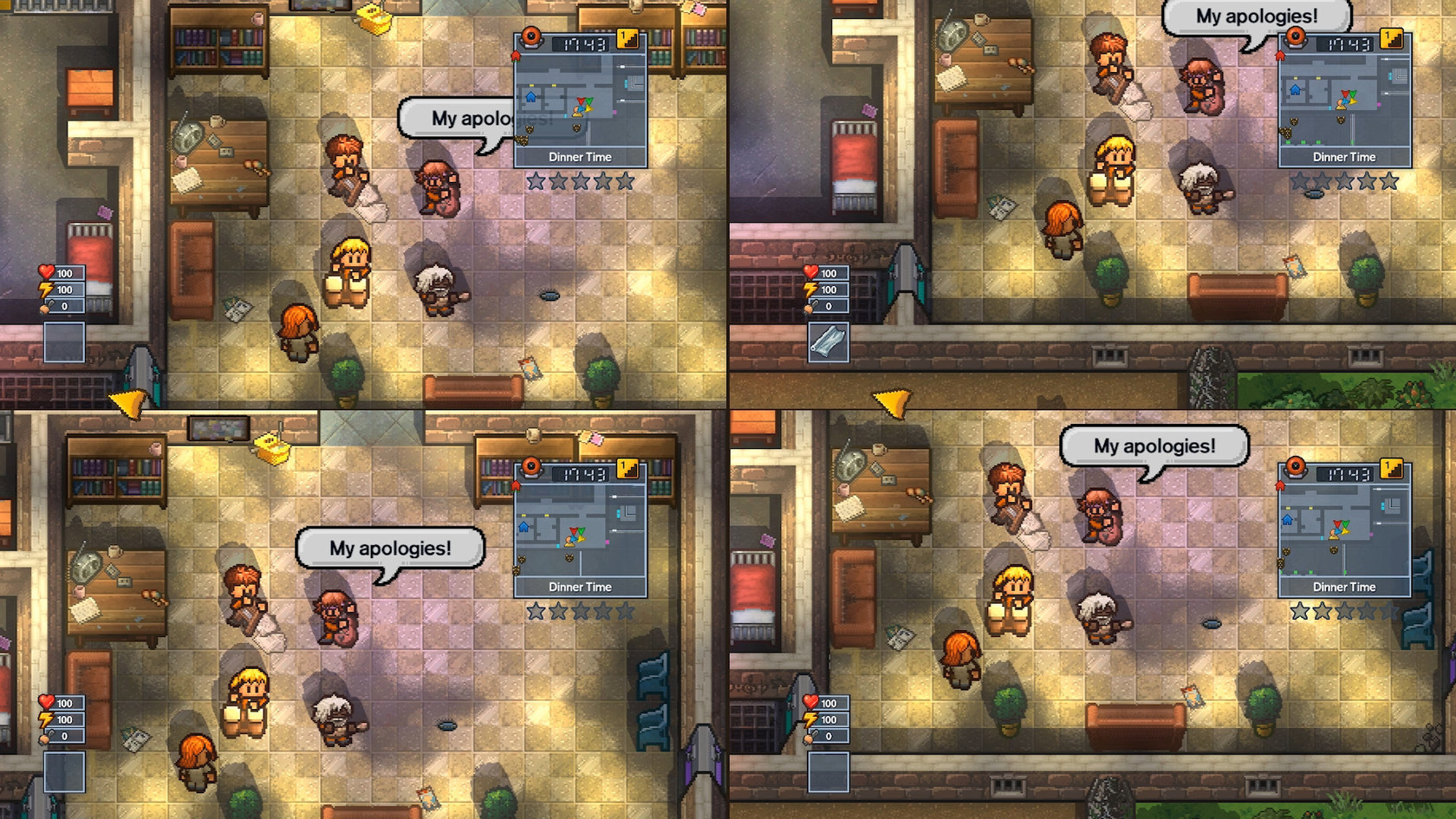Couch Breakout Mac OS
There's a similar question about running breakout on Linux variants: Can't run Breakout outside of appliance My question is specifically about compiling breakout (and hence SPL) on Mac OS X. Note: Users joined into the Zoom meeting from the Zoom Desktop Client, Zoom Mobile App, or H.323/SIP devices can participate in breakout rooms. Users joined via the web client, Chromebooks/Chrome OS or Zoom Rooms are unable to join Breakout Rooms, but the main room can be used as an alternative session for these users. Joining a Breakout Room. Risk it all to breakout from the toughest prisons in the world. Explore the biggest prisons yet, with multiple floors, roofs, vents and underground tunnels. You’ll have to live by the prison rules, attending roll call, doing prison jobs and following strict routines; all the while secretly engineering your bid for freedom! From Community to The Twilight Zone, Netflix continues to add more bingeable TV shows every week! Here are the best shows available for you to stream right now.
Warning
CouchDB 3.0+ will not run without an admin user being created first.Be sure to create an admin user before startingCouchDB!
1.1.1. Installation using the Apache CouchDB convenience binary packages¶
If you are running one of the following operating systems, the easiest wayto install CouchDB is to use the convenience binary packages:
- CentOS/RHEL 7
- CentOS/RHEL 8
- Debian 9 (stretch)
- Debian 10 (buster)
- Ubuntu 16.04 (xenial)
- Ubuntu 18.04 (bionic)
- Ubuntu 20.04 (focal)
These RedHat-style rpm packages and Debian-style deb packages will install CouchDB at/opt/couchdb and ensure CouchDB is run at system startup by the appropriate initsubsystem (SysV-style initd or systemd).
The Debian-style deb packages also pre-configure CouchDB as a standalone or clusterednode, prompt for the address to which it will bind, and a password for the admin user.Responses to these prompts may be pre-seeded using standard debconf tools. Furtherdetails are in the README.Debian file.
For distributions lacking a compatible SpiderMonkey library, Apache CouchDBalso provides packages for the 1.8.5 version.
1.1.1.1. Enabling the Apache CouchDB package repository¶
Debian or Ubuntu: Run the following commands:
RedHat or CentOS: Run the following commands:
1.1.1.2. Installing the Apache CouchDB packages¶
Debian or Ubuntu: Run the following commands:
Debian/Ubuntu installs from binaries can be pre-configured for single node orclustered installations. For clusters, multiple nodes will still need to bejoined together and configured consistently across all machines; follow theCluster Setupwalkthrough to complete the process.
RedHat/CentOS: Run the command:
Once installed, create an admin user by hand beforestarting CouchDB, if your installer didn’t do this for you already.
You can now start the service.
Your installation is not complete. Be sure to complete theSetupsteps for a single node or clustered installation.
Relax! CouchDB is installed and running.
1.1.1.3. GPG keys used for signing the CouchDB repositories¶

As of 2021.04.25, the repository signing key for both types of supported packagesis:
As of 2021.04.25, the package signing key (only used for rpm packages) is:
Both are available from most popular GPG key servers.
1.1.2. Installation from source¶
The remainder of this document describes the steps required to install CouchDBdirectly from source code.
This guide, as well as the INSTALL.Unix document in the official tarballrelease are the canonical sources of installation information. However, manysystems have gotchas that you need to be aware of. In addition, dependenciesfrequently change as distributions update their archives.
1.1.3. Dependencies¶
You should have the following installed:
It is recommended that you install Erlang OTP R16B03-1 or above where possible.You will only need libcurl if you plan to run the JavaScript test suite. Andhelp2man is only need if you plan on installing the CouchDB man pages.Python and Sphinx are only required for building the online documentation.Documentation build can be disabled by adding the --disable-docs flag tothe configure script.
1.1.3.1. Debian-based Systems¶
You can install the dependencies by running:
Be sure to update the version numbers to match your system’s availablepackages.
1.1.3.2. RedHat-based (Fedora, Centos, RHEL) Systems¶
You can install the dependencies by running:
While CouchDB builds against the default js-devel-1.7.0 included in somedistributions, it’s recommended to use a more recent js-devel-1.8.5.
Warning: To build a release for CouchDB the erlang-reltool package is required,yet on CentOS/RHEL this package depends on erlang-wx which pulls in wxGTKand several X11 libraries. If CouchDB is being built on a console onlyserver it might be a good idea to install this in a separate step to therest of the dependencies, so that the package and all its dependenciescan be removed using the yumhistory tool after the release is built.(reltool is needed only during release build but not for CouchDB functioning)
The package can be installed by running:
1.1.3.3. Mac OS X¶
Follow Installation with Homebrew reference for Mac App installation.
If you are installing from source, you will need to install the CommandLine Tools:
You can then install the other dependencies by running:
You will need Homebrew installed to use the brew command.
Some versions of Mac OS X ship a problematic OpenSSL library. Ifyou’re experiencing troubles with CouchDB crashing intermittently witha segmentation fault or a bus error, you will need to install your ownversion of OpenSSL. See the wiki, mentioned above, for more information.
See also
1.1.3.4. FreeBSD¶
FreeBSD requires the use of GNU Make. Where make is specified in thisdocumentation, substitute gmake.
You can install this by running:
1.1.4. Installing¶
Once you have satisfied the dependencies you should run:
If you wish to customize the installation, pass --help to this script.
If everything was successful you should see the following message:
Relax.
To build CouchDB you should run:
Try gmake if make is giving you any problems.
If include paths or other compiler options must be specified, they can be passed to rebar, which compiles CouchDB, with the ERL_CFLAGS environment variable. Likewise, options may be passed to the linker with the ERL_LDFLAGS environment variable:
If everything was successful you should see the following message:
Relax.
Note: a fully-fledged ./configure with the usual GNU Autotools optionsfor package managers and a corresponding makeinstall are indevelopment, but not part of the 2.0.0 release.
1.1.5. User Registration and Security¶
For OS X, in the steps below, substitute /Users/couchdb for/home/couchdb.
You should create a special couchdb user for CouchDB.
On many Unix-like systems you can run:
On Mac OS X you can use the Workgroup Manager to create users up to version10.9, and dscl or sysadminctl after version 10.9. Search Apple’s supportsite to find the documentation appropriate for your system. As of recentversions of OS X, this functionality is also included in Server.app,available through the App Store only as part of OS X Server.

You must make sure that the user has a working POSIX shell and a writablehome directory.
You can test this by:
- Trying to log in as the
couchdbuser - Running
pwdand checking the present working directory
As a recommendation, copy the rel/couchdb directory into/home/couchdb or /Users/couchdb.
Ex: copy the built couchdb release to the new user’s home directory:
Change the ownership of the CouchDB directories by running:
Change the permission of the CouchDB directories by running:
Couch Breakout Mac Os Catalina
Update the permissions for your ini files:
1.1.6. First Run¶
Note
Be sure to create an admin user before trying tostart CouchDB!
You can start the CouchDB server by running:
Couch Breakout Mac Os X
This uses the sudo command to run the couchdb command as thecouchdb user.
When CouchDB starts it should eventually display following messages:
Don’t be afraid, we will fix this in a moment.
To check that everything has worked, point your web browser to:
From here you should verify your installation by pointing your web browser to:
Your installation is not complete. Be sure to complete theSetupsteps for a single node or clustered installation.
1.1.7. Running as a Daemon¶
CouchDB no longer ships with any daemonization scripts.
The CouchDB team recommends runit torun CouchDB persistently and reliably. According to official site:
Configuration of runit is straightforward; if you have questions, contactthe CouchDB user mailing listor IRC-channel #couchdbin FreeNode network.
Let’s consider configuring runit on Ubuntu 16.04. The followingsteps should be considered only as an example. Details will varyby operating system and distribution. Check your system’s packagemanagement tools for specifics.
Install runit:
Create a directory where logs will be written:
Create directories that will contain runit configuration for CouchDB:
Create /etc/sv/couchdb/log/run script:
Basically it determines where and how exactly logs will be written.See mansvlogd for more details.
Create /etc/sv/couchdb/run:
This script determines how exactly CouchDB will be launched.Feel free to add any additional arguments and environmentvariables here if necessary.
Make scripts executable:
Then run:
In a few seconds runit will discover a new symlink and start CouchDB.You can control CouchDB service like this:
Naturally now CouchDB will start automatically shortly after system starts.
You can also configure systemd, launchd or SysV-init daemons to launchCouchDB and keep it running using standard configuration files. Consultyour system documentation for more information.
Couch Breakout Mac Os Download
- Participating in Zoom Breakout Rooms - Windows and Mac
Overview
Mac Os Mojave
Breakout rooms are sessions that are split off from the main Zoom meeting. They allow the participants to meet in smaller groups. Breakout rooms can be used for collaboration and discussion of the meeting.
Prerequisites
- Join the meeting by the Zoom desktop client, mobile app, phone, or H.323/SIP device
- Invitation to join breakout rooms from the meeting host
Note: Users joined into the Zoom meeting from the Zoom Desktop Client, Zoom Mobile App, or H.323/SIP devices can participate in breakout rooms. Users joined via the web client, Chromebooks/Chrome OS or Zoom Rooms are unable to join Breakout Rooms, but the main room can be used as an alternative session for these users.
Joining a Breakout Room
- The host will need to invite you to join the breakout room.
- Click Join.
- If you choose Later, you can join by clicking the Breakout Rooms option in your meeting controls.
- Click Join Breakout Room.
Participating in the Breakout Room
Once you've joined the breakout room, you will have full controls similar to the meeting. You can:
- Mute/Unmute to speak
- Start/Stop Video
- Participants - view the Participants list
- Share screen - read more about screen sharing
- Chat - type messages to the other participants in your breakout room
- Record - you can record the Breakout Room locally if the host gives you recording permission. Read more about local recording.
- Ask for Help - request help from the meeting host
Asking for Help
If you click Ask for Help, it will notify the meeting host that you need assistance and they will be asked to join your breakout room.
- Click Ask for Help in the meeting controls.
- Confirm that you would like assistance by clicking Invite Host.
Recording while in a Breakout Room
- Ask the host for permission to record. The host needs to allow recording before opening the breakout rooms. If the host has already open the breakouts rooms, they can join your breakout room to allow you to record.
- Click Record in the meeting controls to start a local recording.
- The host will need to invite you to join the breakout room.
- Click the pause or stop icon in the meeting controls to pause or stop the recording.
The recording can also be stopped or paused by clicking the indicator in the top left corner.
Learn more about local recording.
Leaving the Breakout Room
You can leave the breakout room and return to the main meeting session at any time, or you can leave the meeting entirely from the breakout room.
- Click Leave Breakout Room.
- Choose if you want to leave the breakout room or the entire meeting.
- When the host ends the breakout rooms, you will be notified and given the option to return to the main room immediately, or in 60 seconds.
Contact Us
Not finding what you're looking for? Contact Us Directly